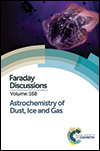Efficient diffusive mechanisms of O atoms at very low temperatures on surfaces of astrophysical interest
Abstract
At the low temperatures of interstellar dust grains, it is well established that surface chemistry proceeds via diffusive mechanisms of H atoms weakly bound (physisorbed) to the surface. Until recently, however, it was unknown whether atoms heavier than hydrogen could diffuse rapidly enough on interstellar grains to react with other accreted species. In addition, models still require simple reduction as well as oxidation reactions to occur on grains to explain the abundances of various molecules. In this paper we investigate O-atom diffusion and reactivity on a variety of astrophysically relevant surfaces (water ice of three different morphologies, silicate, and graphite) in the 6.5–25 K temperature range. Experimental values were used to derive a diffusion law that emphasizes that O atoms diffuse by quantum mechanical tunnelling at temperatures as low as 6.5 K. The rates of diffusion on each surface, based on modelling results, were calculated and an empirical law is given as a function of the surface temperature. The relative diffusion rates are kH2Oice > ksil > kgraph ≫ kexpected. The implications of efficient O-atom diffusion over astrophysically relevant time-scales are discussed. Our findings show that O atoms can scan any available reaction partners (e.g., either another H atom, if available, or a surface radical like O or OH) at a faster rate than that of accretion. Also, as dense clouds mature, H2 becomes far more abundant than H and the O : H ratio grows, and the reactivity of O atoms on grains is such that O becomes one of the dominant reactive partners together with H.
- This article is part of the themed collection: Astrochemistry of Dust, Ice and Gas

 Please wait while we load your content...
Please wait while we load your content...